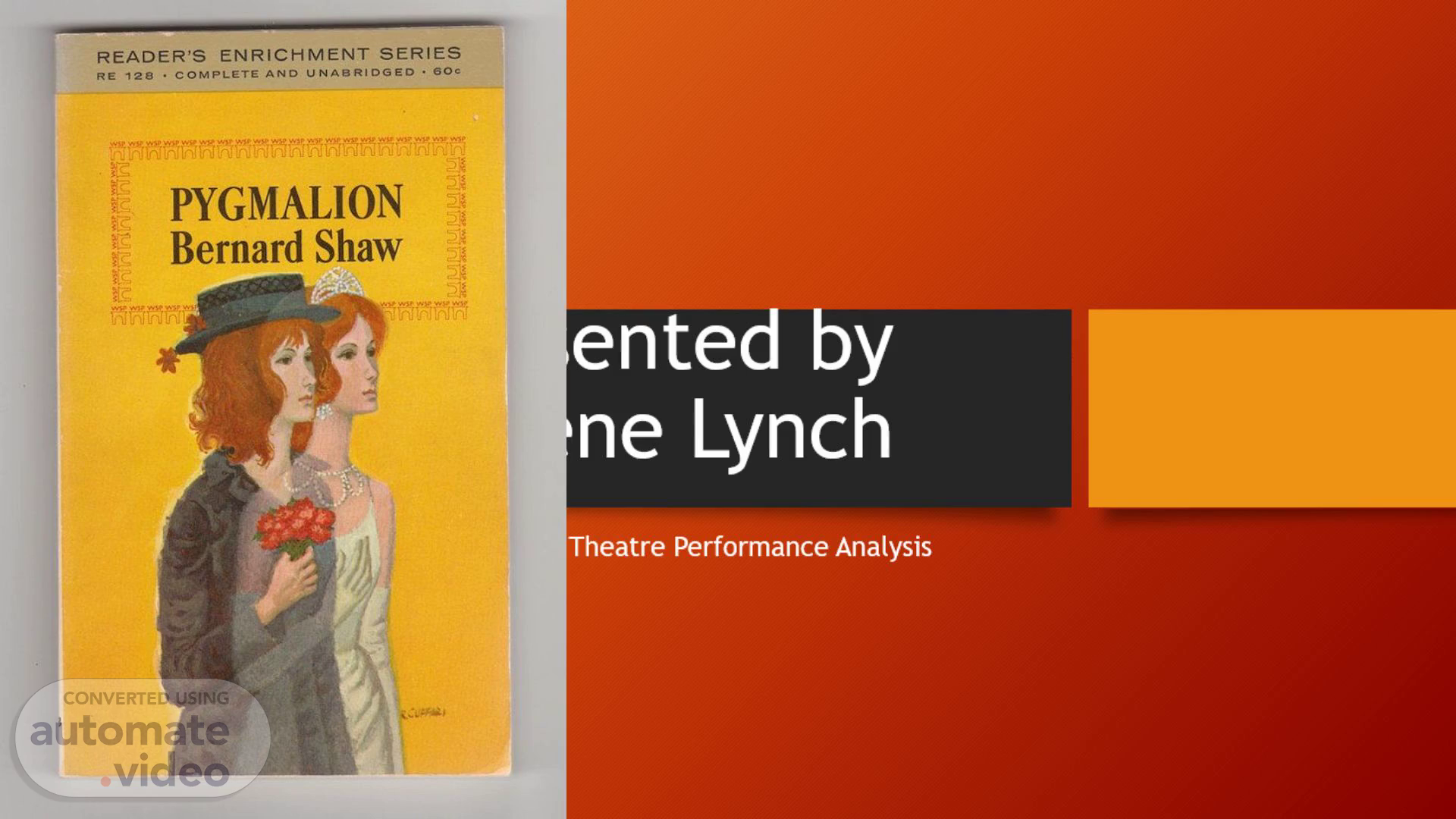Scene 1 (0s)
[Audio] Pygmalion is a play by George Bernard Shaw, which premiered in 1913 at His Majesty's Theatre in London. The Irish playwright Shaw was well-liked for both his wit and his commentary about society. He used this play to touch on class and identity in British society. Pygmalion quickly became famous not only for its humor but also for its incisive comments; it is now considered one of Shaw's most famous plays..
Scene 2 (27s)
Pygmalion. Pygmalion: Summary, Characters, Themes and More.
Scene 3 (38s)
[Audio] The play follows the story of Professor Henry Higgins, a specialist in phonetics, who makes a bet that he can take Eliza Doolittle, a poor flower girl, and turn her into a refined lady by teaching her only to speak properly. As time progresses, Eliza blossoms not just in the way she speaks but in her identity, which challenges the perceptions of everyone who comes into contact with her. Ultimately, Pygmalion undermines any assertion of class and identity, leaving its audiences with an unconventional ending that stresses personal growth over the resolution of romance..
Scene 4 (1m 15s)
[Audio] Pygmalion debuted during a period of unprecedented social flux in Britain, weighed by the Edwardian rigid class system and the growing suffrage movements among women and workers. Shaw, being an archenemy of class differences and a servant for socialism, puts this play into use in order to point out the superficial precepts of social class and bring out the possibility of self-reinvention irrespective of one's background. The context of the play parallels Shaw's own progressiveness and the early 20th-century push for social equality..
Scene 5 (1m 51s)
[Audio] The main characters are Henry Higgins, Eliza Doolittle, and Colonel Pickering. Higgins is a brilliant but arrogant professor of linguistics, inspired by intellectual curiosity or the urge to prove his ability in the transformation of Eliza. Eliza, initially in the story, was looking for ways to improve her position in society; soon she finds herself driven by a yearning for respect and independence. Meanwhile, Colonel Pickering acts out of a real politeness and concern for Eliza, much softer in comparison with Higgins..
Scene 6 (2m 29s)
[Audio] Pygmalion is divided into five acts; each describes an important moment in Eliza's transformation. The whole play takes two to three hours to act out. Shaw did an unconventional thing in that he did not take a romantic resolution, and the stage directions were detailed-things he actually did instead of a focus on the development of character and critique of society. This structure helps underpin a tale of identity and self-discovery rather than a conventional romance..
Scene 7 (3m 1s)
[Audio] Shaw uses language in Pygmalion to show class differences and is, therefore, one of the strong leading ideas within the play. Some characters, like Eliza, bear traces of their low position first and foremost in their accents and dialects, while Higgins approaches others using only formal, very often disdainful colloquial speech. Indeed, the change in Eliza's manner of speaking appropriately marks her rise up the social ladder and the breaking of the judgmental stereotypes against her. Shaw's dialogue in the play is razor-sharp, witty, and full of irony, producing humor and depth in the interactions among characters..
Scene 8 (3m 43s)
[Audio] Pygmalion attacks the class system in England and the superficial decisions related to language and social standing. The play engages in early 20th-century debates about class mobility, women's roles, and self-identity, challenging audiences to revise their prejudices about those coming from different social spheres. Shaw here comments on society, which has been divided by class, yet is ready for change-a representation of his socialist ways of thought, calling for much more equality..
Scene 9 (4m 14s)
[Audio] George Bernard Shaw (1856–1950) was an Irish playwright, critic, and social activist. George Bernard Shaw was born into abject poverty and coloured his perception of class and disparity with sharp wit to match his advocacy of social reform. His works often reflect his socialist ideals of gender equality, economic reform, and the abolition of class privilege. Shaw's experiences and values are reflected in Pygmalion, in which he discusses social class and personal transformation..
Scene 10 (4m 50s)
[Audio] Pygmalion has been translated into numerous adaptations, most famously the 1956 musical My Fair Lady, which added a romantic subplot not present in Shaw's original. The 1964 film version of My Fair Lady carried the story to a whole new audience. Contemporary productions often frame Eliza's story as one of empowerment, refracting her journey through the prism of current thinking on gender and identity. What audiences at the time largely considered to be a comic romp might today be viewed through lenses of personal agency and critique of society..
Scene 11 (5m 29s)
[Audio] I find Pygmalion to be an incredibly thought-provoking yet humorously entertaining play. Shaw's pointed critique of social class, mixed with his quick wit regarding the dialogue, has created a storyline that is quite relevant today. Light on identity, language, and social perception, this humorously insightful treatment provides some real lessons in self-worth and resilience. Pygmalion stands out from most plays because of its social critique and complex, multidimensional characters. The play is timeless, challenging all sorts of societal expectations within the theatre world. ..
